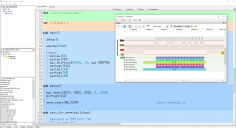[Very] Low Cost Logic Analyzer
 JonnyMac
Posts: 9,575
JonnyMac
Posts: 9,575
This is one of those devices that was so far below the threshold of pain for a tool purchase that I decided to give it a go.
-- https://www.amazon.com/gp/product/B077LSG5P2
It will work with a nifty piece of cross-platform freeware called PulseView.
-- https://sigrok.org/wiki/Main_Page
I've been putting the combo to work while wringing out my P2 objects. The attached screen shots show work on my SPI and 1-Wire code.
-- https://www.amazon.com/gp/product/B077LSG5P2
It will work with a nifty piece of cross-platform freeware called PulseView.
-- https://sigrok.org/wiki/Main_Page
I've been putting the combo to work while wringing out my P2 objects. The attached screen shots show work on my SPI and 1-Wire code.




Comments
I think the 24MHz 8 bit Logic Analyzer units pretty much all use the Cypress CY7C68013A, (HS-USB+MCU) and there are many bare modules using this too.
A nice case is good to have, as it's harder to lose, and harder to damage
https://www.ebay.com/b/Usb-Logic-Analyzer/97231/bn_7023295615
I like the fact PulseView is open source and has many decoders. It also supports Saleae so I will give it a try.
Yes, P2 can manage faster burst captures, but the Serial USB is not as fast as HS-USB.
I see examples like this
https://sigrok.org/wiki/IKALOGIC_ScanaPLUS
use a RLE scheme, this one has 9 bits of data and 7 bits of length.
Even that has a high idle bandwidth, so you could use a LEN=0 as a x127 or x100 time-expander, and that drops an idling 200Msps P2 to issuing
200M/127/2^9 = 3075.78 reports/second, which is an easy 62k baud.
The UB3 can accept bursts of up to 1536 bytes at 6M.8.n.2, above that, the P2 needs to smooth things to average about half that.
eg A P2 could capture alternating buffers, of 1ms or 200k/buffer at 200Msps, and the completed buffer would be RLE compressed and sent.
Somewhere around an average of 250 k Toggles / second 8b wide could be reported, quasi real time, with an edge resolution of 5ns.
That's enough to capture a Si5351 loading for example, but fully Logic-capturing a P1 loading from EEPROM would be a challenge.
I've had one of these for several years, it has worked perfectly with the Saleae software. It did rattle when I first got it, opening it revealed a loose ball of solder.
I paid about $15 for mine. The Saleae hardware is very nice but even at half price ($199) for "Electronic Enthusiasts" it's far too much. When I can buy a dozen of these for the price of one of their units, it becomes a no-brainer.
I do recognize that Saleae has development expenses for the software. I reached out to them a few years ago about buying a license for the software alone. They weren't interested. I think they're missing an opportunity.
The problem is most hobbyists aren't willing to pay a fair price for a commercial product. If some company copies your product and produces it for almost zero margin because they didn't have any development costs, the original company misses out on the volume sales and so takes waaay longer to claw back their development costs. So why would they make their software available on the cheap to support the copied hardware??? Doesn't make commercial sense does it!
Because now they get no money, when I'm using a open source software product like pulseview
How much of that $399 (professional) analyzer price is the choice of colors and the fancy case? I don't give a hoot what it looks like as long as it works. Even at $199 (hobbyist) it would be the most expensive piece of equipment purchased for my on-the-cheap hobby. If they had a bare-bones model (no analog, less bandwidth, no test leads, 4 channels, etc.) I'd consider one at about $75 maximum. I just can't justify spending money for features I don't need. They already did.
I just watched ebay a bit and jumped on a Discovery2 with all the EE student lab add-ons for under $200 and got a great deal. WaveForms works across multiple platforms. I did buy the scope probe board. Very useful addition. Have not even begun to go deep into the D-2 possibilities yet......
You could always justify to your SO that a useful tool for your hobby is cheaper than drinking......
True, but it doesn't quench a thirst as well ;-)
Thanks for alerting us to this very powerful debugging technique.
From Jon; "It would be fun to have a background cog spitting out a stream that PulseView understands -- you can't beat the price, and with the builtin decoders it's a nice little tool."
I hope someone can write a note to assist newcomers on implementing PulseView debugging using P1 and P2.
Perhaps a sample application using a simple, well known cheap device like a DS RTC chip.
Hi, the DMX decoder is called DMX512, maybe that works even better for you.
As for p2 support - we'd sure be glad to add support for any device but personally I find that emulating common devices is a sane approach as well. In particular, the SUMP protocol and its extensions (e.g. from Pipistrello OLS) are worth a look.